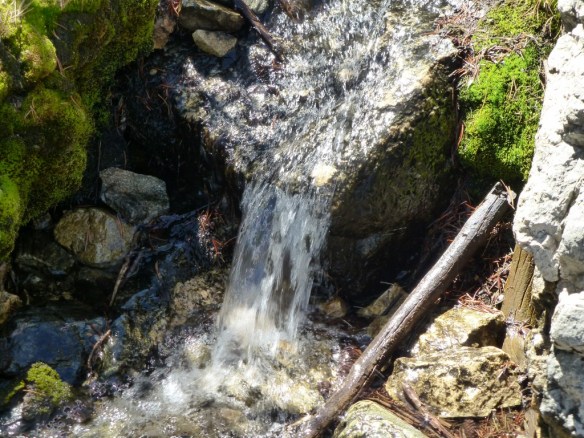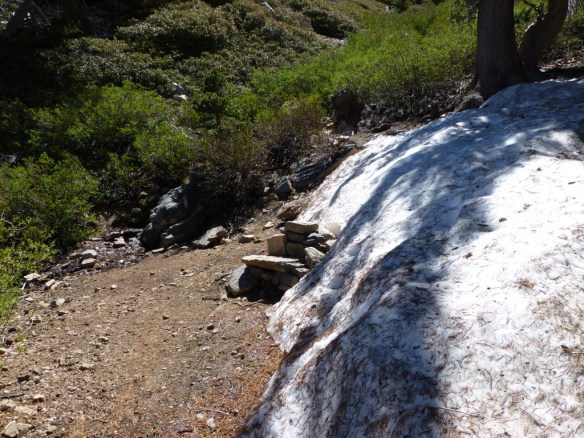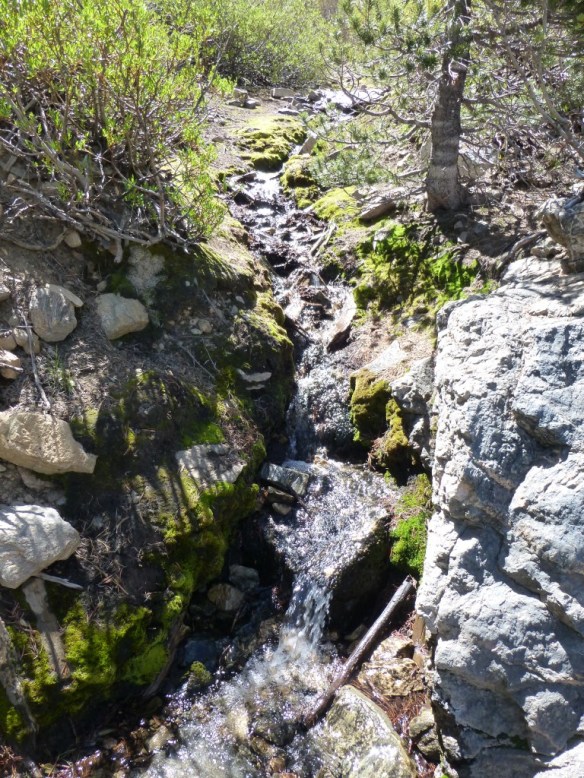With the budget cuts that have so negatively impacted the Forest Service, I understand that a ranger station may not know the answer to a question. We all are dealing with those impacts and a simple “I don’t know” is understandable (though unfortunate and disappointing). However, I don’t understand giving out false information—especially in regards to something like the presence of water at an essential water source. Some minimum standard of assessing the truth value of information should be in place prior to a ranger station passing that information along to the public.
False Information Given
Since I was backpacking with three others on Saturday, I called the Mill Creek Ranger Station Friday afternoon and asked how much water was available at Limber Pine Springs. I was told that water is present but that I needed to bring all the water I required. I went round and round with the person on the phone trying to ascertain what he meant. He just kept repeating the same thing which I found nonsensical. If there is water, why would I want to carry at least 6 extra liters? I let everyone know that we might have a water issue and to bring enough water for the whole trip but that we would also stop by the Mill Creek Ranger Station to get better information in person. The information over the phone didn’t make sense as I’d hiked up the Vivian Creek Trail a few weeks earlier (when I also picked up the permit for this trip) and there was plenty of water then.
On Saturday we stopped by the Mill Creek Ranger Station and got more definitive answers (which turned out to be categorically false). Initially we got a similar response indicating some water existed but that we needed to carry up all the water we would require. None of us wanted to carry up all that extra water, so we talked about how we were backpacking and how much extra water that would be. I told them I’d hiked there before and knew where the spring was and mentioned that even if it wasn’t visible from the trail I’d know where to find its source etc. The more we asked the more definitive they became (including body language like shaking their heads no) telling us it was dry at Limber Pine Springs. They were adamant that we bring up all the water we would need for a two day backpacking trip.
Actual Conditions
It was over 90 degrees at the trailhead and loading up our packs with close to 14 pounds of extra water each was brutal. About a quarter mile up the trail I was already concerned that I was drinking too much water due to the strain of carrying so much extra weight. By the time we reached the Wilderness Boundary sign I was thinking about what part of the trail would be our latest turn back point if we needed to abandon our trip. About a quarter mile later we met a hiker who was coming down from Limber Pine Bench. Although he didn’t make it up to the springs he mentioned that he has hiked this trail for fifteen years and has never seen Limber Pine Springs dry. Sure, we might need to hike up above the trail to reach the springs but he was certain enough water would be flowing to filter. He suggested we pour out our excess water. However, given the certainty presented at the ranger station, we weren’t confident enough to trust the word of one person who didn’t actually see water. Fortunately, within another quarter mile a group of hikers passed us who were coming down from the peak and confirmed that there was plenty of water, that it crossed the trail, and that there was still snow on the trail by the spring. We decided to pour out some water as soon as we got a couple hundred yards up the trail to a flatter area where we could also stop and eat lunch. Along the way we met another group of hikers coming down from the peak that confirmed that there was water and snow at the spring. This further confirmation gave us the confidence to pour out about 6 liters of water each. Even after pouring out our water we asked the same question to each group of hikers passing us on their way down from San Bernardino Peak and got the same response.
Perhaps most surprising was that there was so much water at Limber Pine Springs that we could hear it flowing down the mountain over the sound of our trekking poles at least a couple hundred feet before seeing it cross the corner of trail.

Close up of where I was able to fill a dry sack with about three liters of water in a few seconds– which I filtered at the bench nearby (photo taken June 2, 2013)
Following Up And A Suggestion
This morning (Monday) I called the Mill Creek Ranger Station to let them know what the actual conditions were. Before I could explain why I was calling I was given a more accurate report (though still over cautious enough for me to want to explain exactly what I saw). While explaining what happened to us I learned that someone they knew stopped into the ranger station late Saturday and gave them better information. I was told that prior to that they were just “sharing what they were told.” I find the idea that someone could see the conditions I saw and report back that water was so low that water couldn’t be guaranteed to be there impossible to believe. Further, given the reaction of the hiker who has hiked in the area for the last fifteen years, I find it apathetic (at best) that the ranger station would simply accept such a ridiculous report and share it with the public without confirming its truth value. In our back and forth I learned that there currently aren’t enough rangers to give timely updates on water conditions and that they rely on reports from hikers.
As I was giving the woman on the phone my blog address so she could see the photos and internalize how much water is still flowing at Limber Pine Springs, it occurred to me that a system of asking for photos of water sources from hikers could go a long way in providing accurate information to the public. Everyone is required to get a wilderness permit to hike in the San Gorgonio Wilderness (not doing so could land you a “fine of not more than $5,000 or imprisonment for not more than 6 (six) months, or both”). A large number of people pick up their permits at the Mill Creek Ranger Station. It wouldn’t be that difficult to ask for people to volunteer to take photos and share them so that their reports are verifiable. I’m sure enough people would understand the importance of such a system and happily take the photos that a reliable weekly report would be the result. I suggested this idea to the woman on the phone and also suggested that the ranger station just post a sign at the counter to facilitate getting volunteers.
Granted that idea is “off the cuff,” but something needs to change. If I learn about any change in policy from the Mill Creek Ranger Station, I’ll write a follow up story. I realize one alternative is to not trust any information coming from them but that would make the ranger station a joke. Hopefully they will decide they need to do better than that!



Even though my dad was a FS ranger, or maybe BECAUSE he was such a good one, dealing with Forest Service when we’re trying to get information on land status and stuff pretty much gives me a headache. Oh, man. This only confirms that it’s probably best to do as much research as possible on my own, before I ask them questions.
LikeLike
It is pretty sad what the budget cuts have done. I just wish they were more forthcoming and at least disclose they don’t know the answer to a question. Deciding for us what to do with lack of information isn’t helpful. Hopefully your dad can give you some tips on where to research for your journeys.
LikeLike
I find it strange that they wouldn’t know this simple information, though. I’ve done it twice and both times, I ran into rangers hiking the trail to check people’s permits. I also met two rangers at the top of the mountain. They obviously hiked the three main trails up the mountain to catch people. Why wouldn’t these rangers report accurate information to the front desk staffs?
LikeLike
I didn’t meet rangers on my last three trips to the San Gorgonio Wilderness (one from Vivian Creek this year, one from Angelus Oaks this year, and one from Angelus Oaks last year). So, I’m not sure what the frequency of ranger visits are right now due to all the budget cuts. I also find it strange that they are giving out information without having it verified rather than honestly stating that they no longer have the funding to supply accurate information etc.
LikeLike
Some people are stupid bring all you need is what you were told da!!!
LikeLike
At Mill Creek (and probably most) the ranger stations are often augmented by volunteers. I empathize with your frustration and they should have made it clear that the info was from word of mouth and can’t validate the authenticity. This site is being updated to some extent with water availability in San Gorgonio Wilderness:
(http://www.howlingduck.com/cgi-local/display_water_data.pl )
Sometimes the info in it is hit or miss, but yours is a good reminder to include it in my future blogs. Keep on trekking! -J.Lowe
LikeLike
Sorry, forgot about this one too: http://www.sgwa.org/trails.htm
LikeLike
Great info, thanks!
LikeLike
Sounds like their answer is focusing on liability. If they simply don’t know, they should really say so: WE DON’T KNOW. Then it’s up to the hiker to decide. I bet it felt good to dump that water – AFTER you carried it up the first mile of the dreaded Vivian Creek wall.
LikeLike
I agree, we don’t know is a much better reply than giving out completely false information. We were actually on the San Bernardino Peak Trail and it felt great to rid ourselves of the excess water.
LikeLike
Kyle, without really knowing it you are fulfilling at least a portion of the gaping hole that these cuts produced. You’re bringing to light the problems and you’re giving good information, here and throughout your site. The PCT hiking community gets much of its updates through the PCTA.org website where water, trail and fire reports are provided and they seem entirely accurate. We also subscribe to pct-l@backcountry.net which is a kind of list-serve (is that term even used anymore?) with great information provided by the hiking community itself. I mention these only to provide possible models for a solution for trails other than the PCT. How they are financed and hosted, I couldn’t say.
Getting incorrect water reports from anyone, park staff or not, puts a hiker at potentially huge risk. And at eight pounds a gallon that water weighs, it’s a terrible burden to carry more than is necessary.
Best.
LikeLike
Thanks for the nice words about my blog. The PCT system is great and something that is obviously needed to provide one place to get information rather than trying to get it from each forest between Mexico and Canada. I think it is a good example of the kind of thing that may need to emerge for our National Parks and Forests. A key issue would be making the public aware of a website that provides accurate information.
I wish the Forest Service was more upfront with the public in sharing the impacts of the budget cuts. They may never get the funding again that we were used to in the past. As a community, we may need to rely on networks like the PCT one you shared and there needs to be a system in place to help foster their existence.
Unfortunately, it appears that ranger stations (perhaps just some of them) are taking the position to be over cautious in fear of finding themselves in a law suit. I find this an ironic position as wildly inaccurate information (like what I was given) could lead to injury because it isn’t always as obvious as people think on which side to compensate. For example, carrying an extra 14 lbs of water up a steep trail on a hot day could be as problematic physically as running out of water.
LikeLike
I work for the forest service in another state and I can tell you that things are bad. There is no money to hire people and the front desk folks are barely paid a living wage. Most often they are not hikers. Ours do ask people for reports, but most often hikers hit their car and keep going…very rarely do they come back to report. An online forum might work better, some kind of hiker maintained info board. Also, our front desk folk are terrified of liability…if they tell someone it is safe to go somewhere and for whatever reason it is not, they can be sued personally. Sorry you had a bad experience, hope this helps you understand a little bit.
LikeLike
Mary, thanks for your comments. I agree that the funding situation is real bad. That’s why I don’t understand why the Forest Service isn’t more up front with telling the public what they are no longer able to do. For example, if the Mill Creek Ranger Station made it public that they were no longer in a position to give accurate water reports I would have planned a scouting hike just up to the water source about a week before our hike. I like your idea of an online option but it would be useless if the Forest Service didn’t play a key role in informing the public of the existence of the online information. So, I think there would need to be a connection between the Forest Service and the entity running the online presence for the hiker community.
I understand the fear that the “front desk folks” experience. From a “cover your butt” perspective; wouldn’t it make more sense to say you don’t know than to give out patently false information? If I can sue because I was told there was water somewhere where there wasn’t; couldn’t I also sue if I got injured carrying up too much water weight due to being told there wasn’t any water where there was?
I think more public awareness of the negative impacts of these budget cuts is important to either get more funding for the Forest Service or to develop community systems that take over tasks the Forest Service is no longer funded adequately to provide.
LikeLike
Hey bro. I understand your frustration having to carry all that extra water even though you’d gone through the appropriate precautions of calling the rangers, and then asking them in person. As you say, they are likely understaffed. I think your approach of being friendly and offering help is the best.
LikeLike
Thanks bro.
LikeLike